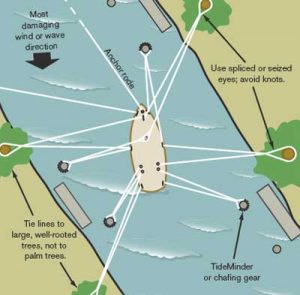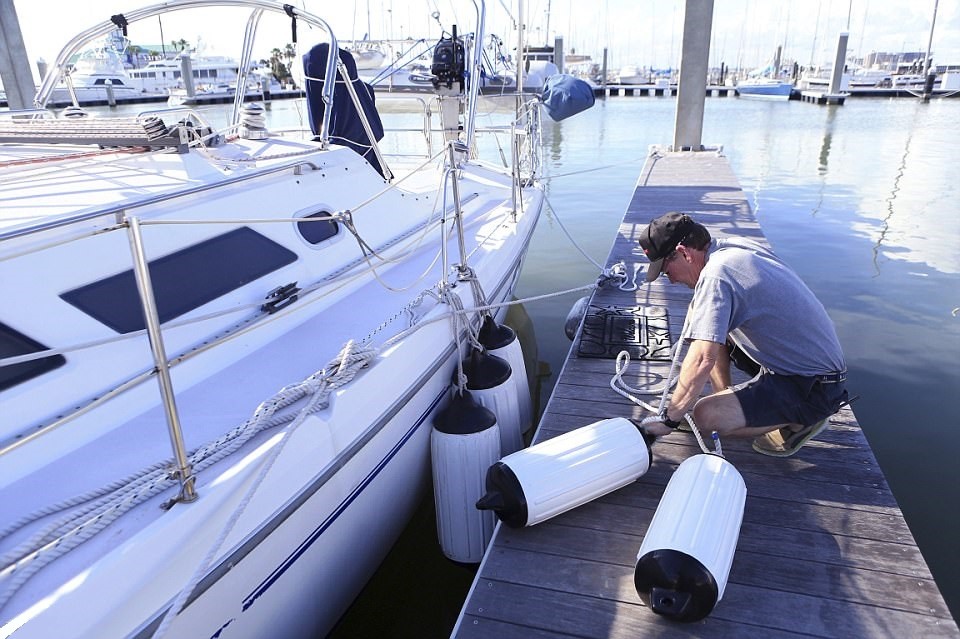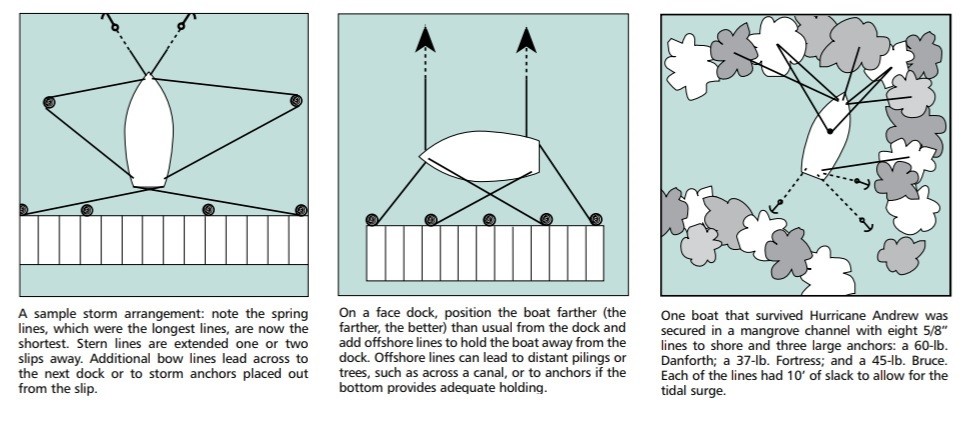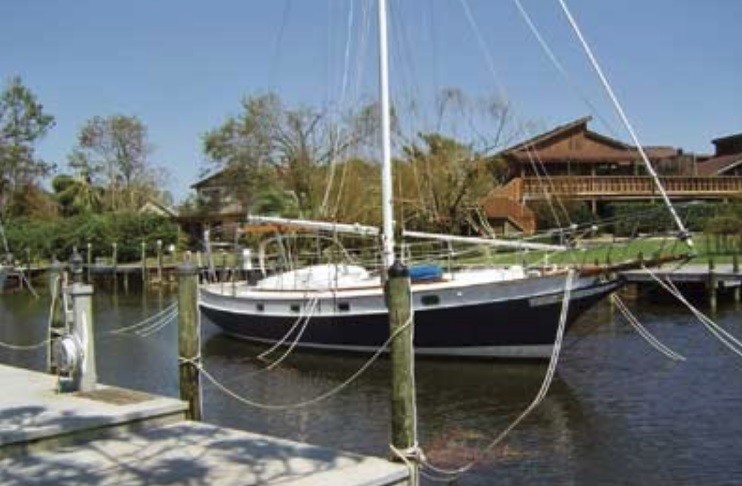Preparing Your Boat or a Hurricane
If you live in a hurricane prone area, preparing your boat for a hurricane is something you must know how to do.
Before the season even starts it’s best to have readily available all the hurricane supplies needed for your boat, including dock lines, boat fenders and covers. And to have a game plan ready!
The good thing about hurricanes is that they don’t occur overnight. You will have approximately a week’s warning to keep an eye on things.
When preparing your boat for a hurricane, always prepare as if the eye is going to go right over your boat.
You should prepare AT LEAST 3 days in advance of projected landfall. Sure, some hurricanes may steer clear of you, but you’re better off safe than sorry should the hurricane come right at you. Also, the earlier you begin making preparations, the less you’ll have to deal with other boat owners frantically relocating their vessels, and taking up all the good spots (if keeping your boat in the water).
Where You Keep Your Boat is The Most Important Hurricane Preparation Decision You Will Make
Important warning – never stay in your boat during a hurricane. People often underestimate a hurricane’s force, magnitude or how its gonna hit, and choose to “brave it out”. Hurricanes are mortally violent, hit in all directions, and there’s no way to be safe while in a boat.
Depending on your boating insurance, you may have requirements as to where you need to moor or store your boat, which may be other than its permanent location. Some insurances may require you to haul and tie down your boat (and can even help cover part of these expenses with haulout coverage, if your coverage includes it). Regardless of insurance requirements, this is the best option.
If keeping your boat on land, you want to put it as close as you can to the side of a solid building that is opposite of the wind direction. At best, you want this at best on high ground, or at least not in flood zones.
Place heavy concrete blocks behind the wheels of your trailer, and deflate tires completely. If placed on jack stands, make sure your boat has extra jack stands, at least three or four on each side for boats under 30’ and five or six for larger boats. The jack stands must be supported by plywood and chained together.
When preparing your boat for a hurricane, it is best to strap your boat to secure anchors, such as eyes set in concrete or helical anchors drilled into the ground. Helical anchors, even in soil, hold thousands of times stronger than mushroom anchors and other types.
Straps with little or no stretch work best (Aramid Kevlar, Twaron, Technora, Nomex); ordinary nylon line stretches, so is not a good option.
Using a broom handle is an easy and effective way to twist helical anchors into the ground.
 If not able to haul and tie down your boat, canals, rivers and waterways are usually your best option in the water. Move as far up the canal as possible; the boat will be better protected from storm surge, you reduce the possibility of blocking access to other boats, and the storm immediately begins to lose strength upon landfall. In canals, try to secure your boat in the center, tying the boat to both sides using the spiderweb technique.
If not able to haul and tie down your boat, canals, rivers and waterways are usually your best option in the water. Move as far up the canal as possible; the boat will be better protected from storm surge, you reduce the possibility of blocking access to other boats, and the storm immediately begins to lose strength upon landfall. In canals, try to secure your boat in the center, tying the boat to both sides using the spiderweb technique.
If this is not possible, marinas with floating docks and tall pilings are another good option, as are Dry Stack-Storage Facilities built after Hurricane Andrew.
Facilities built before Andrew can actually be one of the biggest dangers to your boat. Other bad places to leave your boat during the hurricane are floating docks with short pilings, marinas protected by low-lying seawalls, cramped, fixed docks, or on lifts or davits.
Renting a warehouse built to hurricane resistant code, if available, is an option. The amount spent in rent can be considerably less than the amount of damages sustained from a hurricane.
And of course, the safest option of all, if a possibility, is to place your boat on the trailer and evacuate the hurricane area.
General Guidelines for Preparing Your Boat for a Hurricane – Checklist
If you have no option but to stay put and keep your boat in the water, follow these guidelines for best chances of keeping your boat in good condition. If you find an asterisk at the end of the line, it should also be applied to the boat if hauled out and tied down.
- Strip as much as you can from the vessel topsides. Bimini tops, dinghies, motors, sails, roller furling, outriggers, chairs, cushions and anything else that can go flying should all be stowed.*
- Make sure to close and secure / lock all hatches and openings. Use duct tape to enhance watertight seal. Tape down any original equipment covers.*
- When it comes to tying up a boat for a hurricane, since a hurricane hits in all directions, you need to tie your boat accordingly. You want to tie double lines, cross each cleat, to form two angles and double resistance. Use longer lines, which will allow your boat to rise and fall with the storm surges. The more lines you use, and the longer the lines, the better. The more anchors you use, the better.
- Make sure your lines are new, you don’t want a years old line with wear and tear trying to hold your boat in 100+ mph winds.*
- Add line protectors to ropes wherever lines may cause damage to the boat via friction, and also chain wrapped around the dock cleats, attached to line, so that the rope doesn’t rip apart due to the friction of rubbing against the cleats during the storm.
- Check strength on back plates of all cleats.
- Ensure that batteries are fully charged, so that they can last without shore power for many days, and to power the bilge pumps. Ensure that the bilges work and are clear of debris. Take hull plugs out so that stormwater can drain.
- Tape large windows to hold together should they be hit by an object during storm.*
- Fenders are extremely important. Tie fenders horizontally (stacked) when on a vertical piling, or tie vertically when on a concrete or wooden dock. Once again, the more the better.
- Lift engines so they don’t scrape or so floor level projectiles do not hit the engine.
- Keep water and fuel tanks completely full in order to add weight to your vessel, and to have resources after storm passes
- If you have a sailboat, unstep your masts. Although no one has put a number on it, sailboat masts create a horrendous amount of windage. When Hurricane Ivan battered Pensacola Shipyard and Marine Complex in 2004, all of the sailboats stored ashore that had their masts up were blown over. Conversely, the few sailboats that had their masts unstepped (and all of the powerboats) stored ashore remained upright. Many marinas will offer this service.
How to Anchor a Boat For A Hurricane
When it comes anchoring a boat for a hurricane, one particularly effective anchoring arrangement is to use three heavy, burying-type storm anchors (fluke anchors have been shown to hold best) with chain rodes, deployed 120 degrees apart and connected together using a heavy swivel. Make sure there is a good bottom for holding the anchor.
In all mooring and anchoring arrangements when preparing your boat for a hurricane, increase scope to allow for storm surge — 10:1 if possible. Use heavy, oversized chain and oversized line in an approximate 50/50 ratio for the bow line. If you are using all-chain rode, use a sturdy snubber approximately 1/10 the length of the rode. The addition of a sentinel (riding weight) to the rode will lower the angle of pull on the anchor and reduce jerking and strain on the boat. Remember that additional scope requires additional swinging room.
For another way to anchor a boat for a hurricane, see here.
Need More Info on How to Prepare Your Boat for a Hurricane?
Along with the boating guys in house who’ve had to prepare their boats countless times down here in South Florida, a special thanks to BoatUS, which we referred to quite a bit for ideas for this guide. BoatUS provides boat insurance, water & roadside boat towing, boat lettering, safe boater tips & more. For a wealth of information on preparing your boat for a hurricane, see Boat US’s guides here, here and here, or visit their Hurricane Resource Center.
Have a good one!














2 Comments
I like that you mention using duct tape to enhance the watertight seals on hatches and other openings. It would probably help to also check them to ensure they’re in good condition. If there are any problems, you could install new watertight hatches so that they can be properly sealed and secured.
Good advice. Thank you, Erika